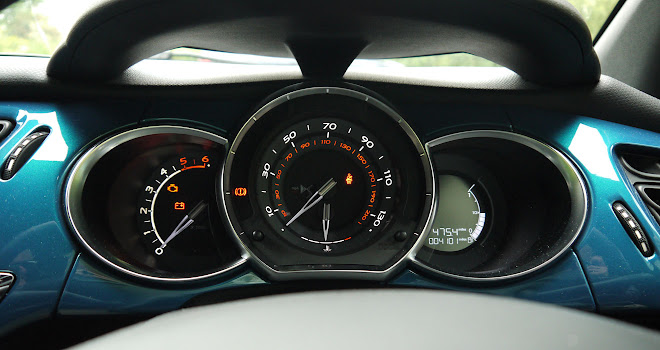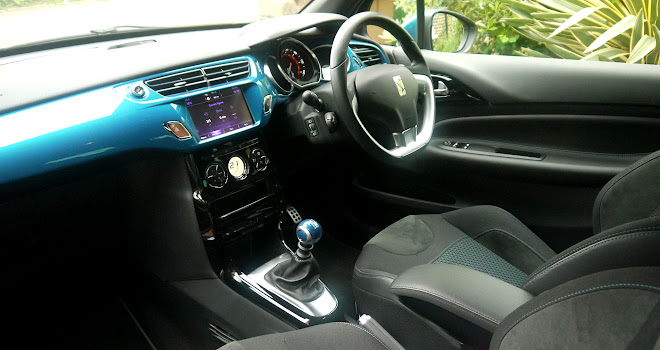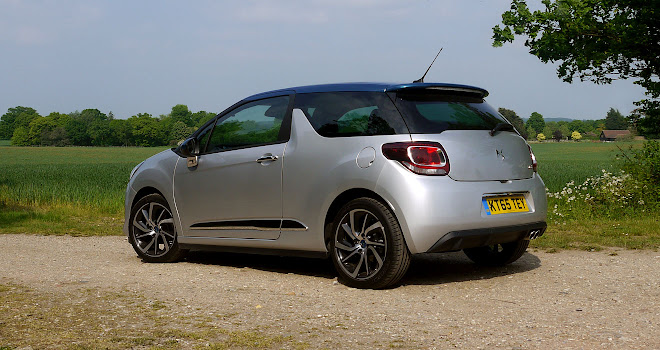by Lem Bingley 
And according to its maker, February saw the arrival of a “new” DS 3. A chrome-ringed grille has been grafted onto the nose and the Citroen chevrons have been chucked in the bin, while the interior has gained a touchscreen and lost about 20 buttons. There are also new personalisation options and additional standard equipment.
But in reality, this car is new only in the eyes of the DS marketing team. Tweaks aside, the car remains extremely familiar to anyone who has driven the old DS 3 on account of having hardly changed at all. Even the car’s swanky LED-and-Xenon headlamps have been around since 2014.

Mostly, this level of continuity is not a bad thing. The years have been kind to the DS 3’s looks and it remains a very handily sized supermini with sensible amounts of interior space. You can squeeze three very close friends across the rear bench and there’s plenty of room in the boot for a big shop or a couple of weeks away. It’s great fun to drive too, with quick steering, impressive brakes and eager response to the throttle.
In other ways familiarity is not so good, especially if the split from Citroen is supposed to signify a push upmarket.
Premium pretensions won’t last long beyond the ringing clang of a slammed door. The ride is crude enough to make your eyeballs vibrate, and the thick windscreen pillars could use some high-strength-steel and a diet. They get in the way so much you need to bob your head like a chicken to check for traffic on roundabouts.

DS 3 is also an upmarket car that doesn’t feature any wheel-mounted buttons, which you will find in the bigger DS 4 and DS 5. My well specified test car featured cruise control switches on one stubby column-mounted stalk and a full set of audio controls on another stubby stalk, neither of which I could see because both stalks were entirely hidden behind the spokes of the steering wheel. You have to learn which button does what by feel, an arrangement that falls somewhat short of a luxury experience. Given that you can find wheel-buttons in a Fiat Panda, it’s clear that the DS 3 is lagging a little behind.
Similarly, while a power socket and USB connector are very welcome, the best place to put them is probably not where the cables will get all tangled up in the handbrake. This is an old annoyance, unchanged from the Citroen DS3 I drove in 2013.

My other big gripe is comfort, or the lack of it. The front seats look very inviting, with deep side bolsters and quality upholstery, but I’ve sat on more cosseting milk crates. The DS 3 is the only car in which I’ve ever felt the need to stop at motorway services to stretch my legs, walk around and have an arse-break.
Fortunately, the DS 3 does bring an armoury of upsides to keep it in the running – most notably some excellent engines. The 120bhp BlueHDi diesel engine fitted to my DS 3 put in a sterling week’s work, averaging 62.7mpg over 474 miles without any special effort on my part to conserve fuel. The six-speed manual gearbox should also share credit for the fuel economy, providing long legs for motorway cruising as well as a clean and snappy feel when zipping around in the lower gears. The 0-62mph time for this car is 9.3 seconds, though it feels quicker still.

The small digital screen at the right of the instrument cluster provides handy upshift hints, though it offered no downshift hints to prevent the onset of a labouring engine (which is also to be avoided if you want to save fuel).
Official figures for the four-cylinder turbo diesel are 94g/km and 78.5mpg. Lower down the range there’s a 100bhp diesel unit that is rated at 87g/km, and three- and four-cylinder petrol options ranging from 100g/km to 129g/km. All but the cheapest petrol engine will come with stop-start fitted. This feature worked entirely reliably during my week with the car, shutting the engine down when put in neutral and starting up promptly with a dip of the clutch.

My diesel option also proved impressively smooth and free of vibration, though not very quiet. It growled, grumbled and groaned at low speeds, but settled down to a pleasant hum at motorway pace. Uncomfortable seat aside, the DS 3 was quite a refined long-distance cruiser. The pedals are offset a little to the right, but at least that means there’s enough room to rest your clutch foot.
Alas there’s no option to specify adaptive cruise control, though there is a forward-looking safety system to stop you hitting things in traffic jams. Called Active City Brake, it will perform an emergency stop to try to prevent collisions below 20mph. It’s an option on mid-range Elegance trim level and fitted as standard to Prestige models and above.
Base model Chic trim starts as low as £13,995 but most DS 3 buyers will wind up somewhere between that and the £25,495 starting price of the sportiest DS 3 at the top of the range.

The car pictured is the Prestige trim level, with a base price of £19,495. It has had another £200 spent on a reversing camera, £495 on a two-colour paint job, £150 on colour-matched interior trim, and £100 on Mirror Screen – a feature that displays smartphone apps on the car’s 7-inch touchscreen, using Apple CarPlay or Android MirrorLink facilities.
Using this feature couldn’t be easier. Plug your phone’s cable into the USB socket, and the car’s touchscreen will prompt you to unlock your phone. Do so and compatible apps will immediately spring to life on the touchscreen. I was quickly able to make voice calls, have text messages read aloud, and have iOS maps running full-screen for route guidance.
Indeed, I’d recommend Mirror Link ahead of the factory fitted eMyWay system for navigation, because the DS software doesn’t recognise postcodes. Tapping in a full address is a pain but, once programmed, the built-in satnav does provide good, accurate guidance – even if the graphics do look clunky and dated.
But that mix of old and new is the DS 3 all over. When it first arrived this car was a showstopper, combining distinctive looks and good value with upmarket materials and an involving drive. It has steadily improved with the addition of new technology, but niggles and faults still remain. I trust DS is working on a real new DS 3 because – with the best will in the world – this isn’t it.


DS 3
Rating: stars
Good: sporty drive, very economical, still looks good
Bad: painful seats, outdated in parts, thick pillars
Price: from £13,995
The DS 3 has been around since 2010 and has become a very familiar shape on UK roads. It’s no longer a Citroen – the DS Automobiles brand has been spun off to find its own fortune – but there’s no mistaking this car’s breadvan outline, wraparound glazing and shark-fin central pillar motif. Rating: stars
Good: sporty drive, very economical, still looks good
Bad: painful seats, outdated in parts, thick pillars
Price: from £13,995
And according to its maker, February saw the arrival of a “new” DS 3. A chrome-ringed grille has been grafted onto the nose and the Citroen chevrons have been chucked in the bin, while the interior has gained a touchscreen and lost about 20 buttons. There are also new personalisation options and additional standard equipment.
But in reality, this car is new only in the eyes of the DS marketing team. Tweaks aside, the car remains extremely familiar to anyone who has driven the old DS 3 on account of having hardly changed at all. Even the car’s swanky LED-and-Xenon headlamps have been around since 2014.

Mostly, this level of continuity is not a bad thing. The years have been kind to the DS 3’s looks and it remains a very handily sized supermini with sensible amounts of interior space. You can squeeze three very close friends across the rear bench and there’s plenty of room in the boot for a big shop or a couple of weeks away. It’s great fun to drive too, with quick steering, impressive brakes and eager response to the throttle.
In other ways familiarity is not so good, especially if the split from Citroen is supposed to signify a push upmarket.
Premium pretensions won’t last long beyond the ringing clang of a slammed door. The ride is crude enough to make your eyeballs vibrate, and the thick windscreen pillars could use some high-strength-steel and a diet. They get in the way so much you need to bob your head like a chicken to check for traffic on roundabouts.

DS 3 is also an upmarket car that doesn’t feature any wheel-mounted buttons, which you will find in the bigger DS 4 and DS 5. My well specified test car featured cruise control switches on one stubby column-mounted stalk and a full set of audio controls on another stubby stalk, neither of which I could see because both stalks were entirely hidden behind the spokes of the steering wheel. You have to learn which button does what by feel, an arrangement that falls somewhat short of a luxury experience. Given that you can find wheel-buttons in a Fiat Panda, it’s clear that the DS 3 is lagging a little behind.
Similarly, while a power socket and USB connector are very welcome, the best place to put them is probably not where the cables will get all tangled up in the handbrake. This is an old annoyance, unchanged from the Citroen DS3 I drove in 2013.

My other big gripe is comfort, or the lack of it. The front seats look very inviting, with deep side bolsters and quality upholstery, but I’ve sat on more cosseting milk crates. The DS 3 is the only car in which I’ve ever felt the need to stop at motorway services to stretch my legs, walk around and have an arse-break.
Fortunately, the DS 3 does bring an armoury of upsides to keep it in the running – most notably some excellent engines. The 120bhp BlueHDi diesel engine fitted to my DS 3 put in a sterling week’s work, averaging 62.7mpg over 474 miles without any special effort on my part to conserve fuel. The six-speed manual gearbox should also share credit for the fuel economy, providing long legs for motorway cruising as well as a clean and snappy feel when zipping around in the lower gears. The 0-62mph time for this car is 9.3 seconds, though it feels quicker still.

The small digital screen at the right of the instrument cluster provides handy upshift hints, though it offered no downshift hints to prevent the onset of a labouring engine (which is also to be avoided if you want to save fuel).
Official figures for the four-cylinder turbo diesel are 94g/km and 78.5mpg. Lower down the range there’s a 100bhp diesel unit that is rated at 87g/km, and three- and four-cylinder petrol options ranging from 100g/km to 129g/km. All but the cheapest petrol engine will come with stop-start fitted. This feature worked entirely reliably during my week with the car, shutting the engine down when put in neutral and starting up promptly with a dip of the clutch.

My diesel option also proved impressively smooth and free of vibration, though not very quiet. It growled, grumbled and groaned at low speeds, but settled down to a pleasant hum at motorway pace. Uncomfortable seat aside, the DS 3 was quite a refined long-distance cruiser. The pedals are offset a little to the right, but at least that means there’s enough room to rest your clutch foot.
Alas there’s no option to specify adaptive cruise control, though there is a forward-looking safety system to stop you hitting things in traffic jams. Called Active City Brake, it will perform an emergency stop to try to prevent collisions below 20mph. It’s an option on mid-range Elegance trim level and fitted as standard to Prestige models and above.
Base model Chic trim starts as low as £13,995 but most DS 3 buyers will wind up somewhere between that and the £25,495 starting price of the sportiest DS 3 at the top of the range.

The car pictured is the Prestige trim level, with a base price of £19,495. It has had another £200 spent on a reversing camera, £495 on a two-colour paint job, £150 on colour-matched interior trim, and £100 on Mirror Screen – a feature that displays smartphone apps on the car’s 7-inch touchscreen, using Apple CarPlay or Android MirrorLink facilities.
Using this feature couldn’t be easier. Plug your phone’s cable into the USB socket, and the car’s touchscreen will prompt you to unlock your phone. Do so and compatible apps will immediately spring to life on the touchscreen. I was quickly able to make voice calls, have text messages read aloud, and have iOS maps running full-screen for route guidance.
Indeed, I’d recommend Mirror Link ahead of the factory fitted eMyWay system for navigation, because the DS software doesn’t recognise postcodes. Tapping in a full address is a pain but, once programmed, the built-in satnav does provide good, accurate guidance – even if the graphics do look clunky and dated.
But that mix of old and new is the DS 3 all over. When it first arrived this car was a showstopper, combining distinctive looks and good value with upmarket materials and an involving drive. It has steadily improved with the addition of new technology, but niggles and faults still remain. I trust DS is working on a real new DS 3 because – with the best will in the world – this isn’t it.




